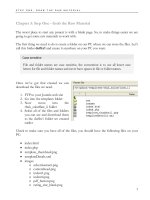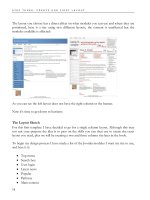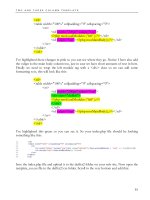A Laboratory Course in C++Data Structures phần 9 potx
Bạn đang xem bản rút gọn của tài liệu. Xem và tải ngay bản đầy đủ của tài liệu tại đây (485.44 KB, 43 trang )
Laboratory 14: Postlab Exercise 1
Hash Table ADT | 327
Name __________________________________________ Date _______________________
Section _________________________________________
Part A
Given a hash table of size T, containing N data items, develop worst-case, order-of-magnitude
estimates of the execution time of the following Hash Table ADT operations, assuming they are
implemented using singly linked lists for the chained data items and a reasonably uniform
distribution of data item keys. Briefly explain your reasoning behind each estimate.
insert O( )
Explanation:
retrieve O( )
Explanation:
Part B
What if the chaining is implemented using a binary search tree instead of a singly linked list?
Using the same assumptions as above, develop worst-case, order-of-magnitude estimates of the
execution time of the following Hash Table ADT operations. Briefly explain your reasoning behind
each estimate.
insert O( )
Explanation:
retrieve O( )
Explanation:
328 | Laboratory 14
Laboratory 14: Postlab Exercise 2
Hash Table ADT | 329
Name __________________________________________ Date _______________________
Section _________________________________________
Part A
For some large number of data items (e.g., N = 1,000,000), would you rather use a binary search
tree or a hash table for performing data retrieval? Explain your reasoning.
Part B
Assuming the same number of data items given above, would the binary search tree or the hash
table be most memory efficient? Explain your assumptions and your reasoning.
Part C
If you needed to select either the binary search tree or the hash table as the best general-purpose
data structure, which would you choose? Under what circumstances would you choose the other
data structure as preferable? Explain your reasoning.
330 | Laboratory 14
In this laboratory you will:
Examine the flaws in the standard C and early C++
string representation
Implement a more robust string data type
Use the C++ operators new and delete to
dynamically allocate and deallocate memory
Create a program that performs lexical analysis using
your new string data type
Analyze the limitations of the default copy
constructor and develop an improved copy
constructor
String ADT
Objectives
Overview
When computers were first introduced, they were popularly characterized as giant
calculating machines. As you saw in your introductory programming course, this
characterization ignores the fact that computers are equally adept at manipulating
other forms of information, including alphanumeric characters.
C++ supports the manipulation of character data through the predefined data type
char and the associated operations for the input, output, assignment, and comparison
of characters. Most applications of character data require character sequences—or
strings—rather than individual characters. A string can be represented in C++ using a
one-dimensional array of characters. By convention, a string begins in array data item
zero and is terminated by the null character (‘\0’). (That is how C and original C++
represented strings. Although C++ now has a standard string class, many current
programming APIs—Application Programming Interfaces—require a knowledge of the C
string representation.)
Representing a string as an array of characters terminated by a null suffers from
several defects, including the following:
• The subscript operator ([]) does not check that the subscript lies within the
boundaries of the string—or even within the boundaries of the array holding the
string, for that matter.
• Strings are compared using functions that have far different calling conventions
than the familiar relational operators (==, <, >, and so forth).
• The assignment operator (=) simply copies a pointer, not the character data it
points to. The code fragment below, for example, makes str2 point to the array
already pointed to by str1. It does not create a new array containing the string
“data”.
char *str1 = “data”,
*str2;
str2 = str1;
Either the length of a string must be declared at compile-time or a program must
explicitly allocate and deallocate the memory used to store a string. Declaring the
length of a string at compile-time is often impossible, or at least inefficient. Allocating
and deallocating the memory used by a string dynamically (that is, at run-time) allows
the string length to be set (or changed) as a program executes. Unfortunately, it is very
easy for a programmer to forget to include code to deallocate memory once a string is
no longer needed. Memory lost in this way—called a memory leak—accumulates over
time, gradually crippling or even crashing a program. This will eventually require the
program or computer system to be restarted.
In this laboratory you will develop a String ADT that addresses these problems.
The following String ADT specification includes a diverse set of operations for
manipulating strings.
332 | Laboratory A
String ADT
Data Items
A set of characters, excluding the null character.
Structure
The characters in a string are in sequential (or linear) order—that is, the characters
follow one after the other from the beginning of a string to its end.
Operations
String ( int numChars = 0 ) throw ( bad_alloc )
Requirements:
None
Results:
Default constructor. Creates an empty string. Allocates enough memory for a string
containing numChars characters plus any delimiter that may be required by the
implementation of the String ADT.
String ( const char *charSeq ) throw ( bad_alloc )
Requirements:
None
Results:
Conversion constructor. Creates a string containing the character sequence in the array
pointed to by charSeq. Assumes that charSeq is a valid C-string terminated by the
null character. Allocates enough memory for the characters in the string plus any
delimiter that may be required by the implementation of the String ADT.
~String ()
Requirements:
None
Results:
Destructor. Deallocates (frees) the memory used to store a string.
int getLength () const
Requirements:
None
Results:
Returns the number of characters in a string (excluding the delimiter).
String ADT | 333
char operator [] ( int n ) const
Requirements:
None
Results:
Returns the nth character in a string—where the characters are numbered beginning
with zero. If the string does not have an nth character, then returns the null character.
void operator = ( const String &rightString ) throw ( bad_alloc )
Requirements:
None
Results:
Assigns (copies) the contents of rightString to a string.
void clear ()
Requirements:
None
Results:
Clears a string, thereby making it an empty string.
void showStructure () const
Requirements:
None
Results:
Outputs the characters in a string, as well as the delimiter. Note that this operation is
intended for testing/debugging purposes only.
334 | Laboratory A
Activities
Assigned: Check or
list exercise numbers Completed
Laboratory A: Cover Sheet
String ADT | 335
Name __________________________________________ Date _______________________
Section _________________________________________
Place a check mark in the Assigned column next to the exercises your instructor has assigned to
you. Attach this cover sheet to the front of the packet of materials you submit following the
laboratory.
Prelab Exercise
Bridge Exercise
In-lab Exercise 1
In-lab Exercise 2
In-lab Exercise 3
Postlab Exercise 1
Postlab Exercise 2
Total
String ADT | 337
Name __________________________________________ Date _______________________
Section _________________________________________
The first decision you must make when implementing the String ADT is how to store the characters
in a string. In the Overview, you saw that original C++ represented a string as a null-terminated
sequence of characters in a one-dimensional buffer. Adopting this representation scheme allows
you to reuse existing C++ functions in your implementation of the String ADT. This code reuse, in
turn, greatly simplifies the implementation process.
Your String ADT will be more flexible if you dynamically allocate the memory used by the
string buffer. The initial memory allocation for a buffer is done by a constructor. One of the
constructors is invoked whenever a string declaration is encountered during the execution of a
program. Which one is invoked depends on whether the declaration has as its argument an integer
or a string literal. Once called, the constructor allocates a string buffer using C++’s new function.
The following constructor, for example, allocates a string buffer of bufferSize characters and
assigns the address of the string buffer to the pointer buffer, where buffer is of type char*.
String:: String ( int numChars )
{
buffer = new char [bufferSize];
}
Whenever you allocate memory, you must ensure that it is deallocated when it is no longer
needed. The class destructor is used to deallocate a string buffer. This function is invoked
whenever a string variable goes out of scope—that is, whenever the function containing the
corresponding variable declaration terminates. The fact that the call to the destructor is made
automatically eliminates the possibility of you forgetting to deallocate the buffer. The following
destructor frees the memory used by the string buffer allocated above.
String:: ~String ()
{
delete [] buffer;
}
Constructors and destructors are not the only operations that allocate and deallocate memory. The
assignment operation also may need to perform memory allocation/deallocation in order to extend
the length of a string buffer to accommodate additional characters.
Strings can be of various lengths, and the length of a given string can change as a result of an
assignment. Your string representation should account for these variations in length by storing the
length of a string (bufferSize) along with a pointer to the buffer containing the characters in the
string (buffer). The resulting string representation is described by the following declarations:
int bufferSize; // Size of the string buffer
char *buffer; // String buffer containing a null-terminated
// sequence of characters
Step 1: Implement the operations in the String ADT using this string representation
scheme. Base your implementation on the following class declaration from
the file stradt.h.
class String
{
public:
// Constructors
String ( int numChars = 0 )
throw ( bad_alloc ); // Create an empty string
String ( const char *charSeq )
throw ( bad_alloc ); // Initialize using char*
// Destructor
~String ();
// String operations
int getLength () const; // # characters
char operator [] ( int n ) const; // Subscript
void operator = ( const String &rightString ) // Assignment
throw ( bad_alloc );
void clear (); // Clear string
// Output the string structure — used in testing/debugging
void showStructure () const;
private:
// Data members
int bufferSize; // Size of the string buffer
char *buffer; // String buffer containing a null-terminated
}; // sequence of characters
Step 2: Save your implementation of the String ADT in the file stradt.cpp. Be sure to
document your code.
338 | Laboratory A
Laboratory A: Bridge Exercise
String ADT | 339
Name __________________________________________ Date _______________________
Section _________________________________________
Check with your instructor whether you are to complete this exercise prior to your lab period
or during lab.
Test your implementation of the String ADT using the program in the file testa.cpp. This
program supports the following tests.
Test Action
1 Tests the constructors.
2 Tests the length operation.
3 Tests the subscript operation.
4 Tests the assignment and clear operations.
Step 1: Compile your implementation of the String ADT in the file stradt.cpp.
Step 2: Compile the test program in the file testa.cpp.
Step 3: Link the object files produced by Steps 1 and 2.
Step 4: Complete the test plan for Test 1 by filling in the expected result for each string.
Step 5: Execute the test plan. If you discover mistakes in your implementation of the String ADT,
correct them and execute the test plan again.
Test Plan for Test 1 (Constructors)
Test Case String Expected Result Checked
Simple string alpha alpha
Longer string epsilon
Single-character string a
Empty string empty
Step 6: Complete the test plan for Test 2 by filling in the length of each string.
Step 7: Execute the test plan. If you discover mistakes in your implementation of the String ADT,
correct them and execute the test plan again.
Test Plan for Test 2 (length Operation)
Test Case String Expected Length Checked
Simple string alpha 5
Longer string epsilon
Single-character string a
Empty string empty
Step 8: Complete the test plan for Test 3 by filling in the character returned by
subscript operation for each value of n and the string “alpha”.
Step 9: Execute the test plan. If you discover mistakes in your implementation of the
String ADT, correct them and execute the test plan again.
Test Plan for Test 3 (subscript Operation)
Test case n Expected character Checked
Middle character 2p
First character 0
Last character 4
Out of range 10
Step 10: Complete the test plan for Test 4 by filling in the expected result for each
assignment statement.
Step 11: Execute the test plan. If you discover mistakes in your implementation of the
String ADT, correct them and execute the test plan again.
Test Plan for Test 4 (assignment and clear Operations)
Test Case Assignment Statement Expected Result Checked
Simple assignment assignStr = alpha; alpha
Single-character string assignStr = a;
Empty string assignStr = empty;
Source string longer than assignStr = epsilon;
destination buffer
Assign to self assignStr = assignStr;
Check assignment by clearing assignStr = alpha;
destination assignStr.clear();
340 | Laboratory A
Laboratory A: In-lab Exercise 1
String ADT | 341
Name __________________________________________ Date _______________________
Section _________________________________________
A compiler begins the compilation process by dividing a program into a set of delimited strings
called tokens. This task is referred to as lexical analysis. For instance, given the C++ statement,
if ( j <= 10 ) cout << endl ;
lexical analysis by a C++ compiler produces the following ten tokens:
“if”“(”“j”“<=”“10”“)”“cout”“<<”“endl”“;”
Before you can perform lexical analysis, you need operations that support the input and output of
delimited strings. A pair of String ADT input/output operations are described below.
friend istream & operator >> ( istream &input,
String &inputString )
Requirements:
The specified input stream must not be in an error state.
Returns:
Extracts (inputs) a string from the specified input stream, returns it in inputString, and returns
the resulting state of the input stream. Begins the input process by reading whitespace (blanks,
newlines, and tabs) until a non-whitespace character is encountered. This character is returned as
the first character in the string. Continues reading the string character by character until another
whitespace character is encountered.
friend ostream & operator << ( ostream &output,
const String &outputString )
Requirements:
The specified output stream must not be in an error state.
Returns:
Inserts (outputs) outputString in the specified output stream and returns the resulting state of
the output stream.
Note that these operations are not part of the String class. However, they do need to have access to
the data members of this class. Thus, they are named as friends of the String class.
Step 1: The file strio.cpp contains implementations of these string input/output operations. Add
these operations to your implementation of the String ADT in the file stradt.cpp.
Prototypes for these operations are included in the declaration of String class in the file
stradt.h.
Step 2: Create a program (stored in the file lexical.cpp) that uses the operations in the
String ADT to perform lexical analysis on a text file containing a C++
program. Your program should read the tokens in this file and output each
token to the screen using the following format:
1 : [1stToken]
2 : [2ndToken]
This format requires that your program maintain a running count of the number of
tokens that have been read from the text file. Assume that the tokens in the text file
are delimited by whitespace—an assumption that is not true for C++ programs in
general.
Step 3: Test your lexical analysis program using the C++ program in the file
progsamp.dat. The contents of this file are shown below.
void main ( )
{
int j ,
total = 0 ;
for ( j = 1 ; j <= 20 ; j ++ )
total += j ;
}
Test Plan for the Lexical Analysis Program
Test Case Expected Result Checked
Program in the file progsamp.dat
342 | Laboratory A
Laboratory A: In-lab Exercise 2
String ADT | 343
Name __________________________________________ Date _______________________
Section _________________________________________
Whenever an argument is passed to a function using call by value, the compiler makes a copy of
the argument. The function then manipulates this copy rather than the original argument. Once the
function terminates, the copy is deleted.
How does the compiler know how to construct a copy of a particular argument? For C++’s
predefined types, this task is straightforward. The compiler simply makes a bitwise (bit by bit) copy
of the argument. Unfortunately, this approach does not work well with instances of the String
class. Consider what happens when the call
dummy(testStr);
is made to the following function:
void dummy ( String valueStr );
A bitwise copy of string testStr to string valueStr copies pointer testStr.buffer to pointer
valueStr.buffer. The string buffer pointed to by testStr.buffer is not copied and there are
now two pointers to the same string buffer. As a result, changes to valueStr also change
testStr, clearly violating the constraints of call by value. In addition, when the function
terminates, the String class destructor is called to delete the copy (valueStr). As it deletes
valueStr’s string buffer, the destructor also is deleting testStr’s string buffer.
Fortunately, C++ provides us with a method for addressing this problem. We can specify
exactly how a copy is to be created by including a copy constructor in our String class. The
compiler then uses our copy constructor in place of its default (bitwise) copy constructor. A copy
constructor for the String class is described below.
String ( const String &valueString ) throw ( bad_alloc )
Requirements:
None
Results:
Copy constructor. Creates a copy of valueString. This constructor is invoked automatically
whenever a string is passed to a function using call by value, a function returns a string, or a
string is initialized using another string.
Step 1: Implement this operation and add it to the file stradt.cpp. A prototype for this operation
is included in the declaration of the String class in the file stradt.h.
Step 2: Activate Test 5 in the test program testa.cpp by removing the comment delimiter (and the
character “5”) from the lines that begin with “//5”.
Step 3: Complete the test plan for Test 5 by filling in the expected result for each string.
Step 4: Execute the test plan. If you discover mistakes in your implementation of the
copy constructor, correct them and execute the test plan again.
Test Plan for Test 5 (Copy Constructor)
Test Case String Argument Expected Result Checked
Simple string alpha alpha
Single-character a
344 | Laboratory A
Laboratory A: In-lab Exercise 3
String ADT | 345
Name __________________________________________ Date _______________________
Section _________________________________________
Most applications that use strings will at some point sort the string data into alphabetical order,
either to make their output easier to read or to improve program performance. In order to sort
strings, you first must develop relational operations that compare strings with one another.
bool operator == ( const String &leftString,
const String &rightString )
Requirements:
None
Results:
Returns true if leftString is the same as rightString. Otherwise, returns false.
bool operator < ( const String &leftString,
const String &rightString )
Requirements:
None
Results:
Returns true if leftString is less than rightString. Otherwise, returns false.
bool operator > ( const String &leftString,
const String &rightString )
Requirements:
None
Results:
Returns true if leftString is greater than rightString. Otherwise, returns false.
All these operations require moving through a pair of strings in parallel from beginning to
end, comparing characters until a difference (if any) is found between the strings. They vary in
how they interpret this difference.
The standard C++ C-string library includes a function strcmp() that can be used to compare
strings character by character. Alternatively, you can develop your own private member function
to perform this task.
Step 1: Implement the relational operations described above using the C++ strcmp() function
(or your own private member function) as a foundation. Add your implementation of
these operations to the file stradt.cpp. Prototypes for these operations are included in the
declaration of the String class in the file stradt.h.
Step 2: Activate Test 6 in the test program testa.cpp by removing the comment
delimiter (and the character ‘6’) from the lines that begin with “//6”.
Step 3: Complete the test plan for Test 6 by filling in the expected result for each pair
of strings.
Step 4: Execute the test plan. If you discover mistakes in your implementation of the
relational operations, correct them and execute the test plan again.
Test Plan for Test 6 (Relational Operations)
Test case Pair of strings Expected result Checked
Second string greater alpha epsilon
First string greater epsilon alpha
Identical strings alpha alpha
First string embedded in second alp alpha
Second string embedded in first alpha alpha
First string is a single character a alpha
Second string is a single character alpha a
First string is empty empty alpha
Second string is empty alpha empty
Both strings are empty empty empty
346 | Laboratory A
Laboratory A: Postlab Exercise 1
String ADT | 347
Name __________________________________________ Date _______________________
Section _________________________________________
In In-lab Exercise 2, you saw that a class’s default copy constructor can cause problems if the class
contains a pointer. Comment out the declaration of the copy constructor in the file stradt.h and
your implementation of this constructor in the file stradt.cpp (assuming you created one in In-lab
Exercise 2). This forces you to use the default copy constructor.
Using the default copy constructor, execute Steps 2, 3, and 4 of In-lab Exercise 2 and explain
the results below.
String ADT | 349
Name __________________________________________ Date _______________________
Section _________________________________________
Part A
Design another operation for the String ADT and give its specification below. You need not
implement the operation, simply describe it.
Requirements:
Results:
Part B
Describe an application in which you might you use your new operation.
350 | Laboratory A
In this laboratory you will:
Create an implementation of the Heap ADT using an
array representation of a tree
Use inheritance to derive a priority queue class from
your heap class and develop a simulation of an
operating system’s task scheduler using a priority
queue
Create a heap sort function based on the heap
construction techniques used in your implementation
of the Heap ADT
Analyze where data items with various priorities are
located in a heap
Heap ADT
Objectives









